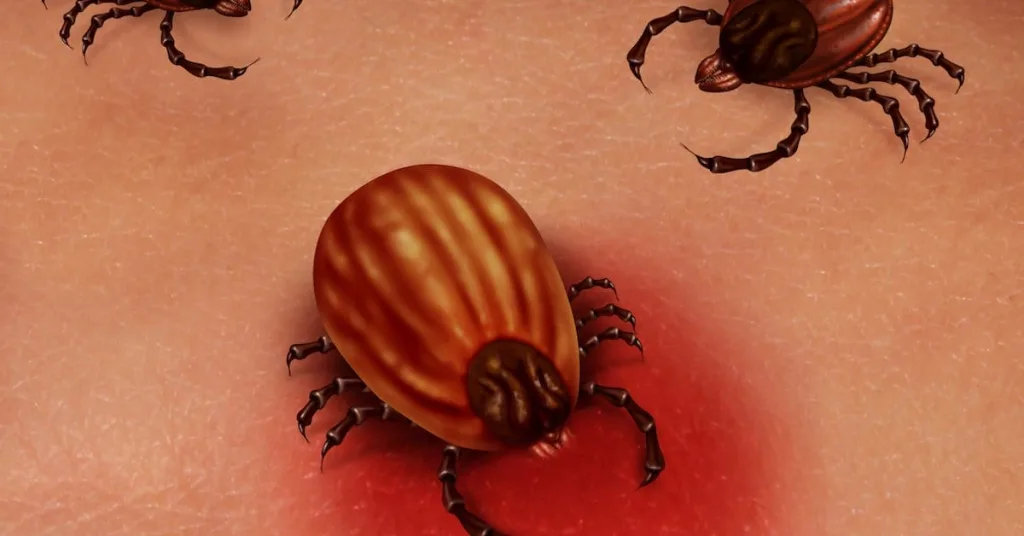Lyme symptoms are characterized by three progressive stages of the disease: early localized, early disseminated, and late disseminated (chronic). Symptoms generally include rash, swelling, headache, fever, and fatigue, but Lyme is called “The Great Imitator” because its symptoms are virtually indistinguishable from over 350 other conditions. Lyme is commonly misdiagnosed without confirmation of a tick bite or a skin rash, delaying critical treatment.
What is Early Localized (Acute) Lyme Disease?
Early localized or acute Lyme disease is the first stage, with symptoms usually beginning a few hours to a few weeks after the tick bite. You cannot notice symptoms during stage one, remaining unaware of the infection until more serious symptoms arise during later stages.
One of the first signs of infection during stage one is the bullseye-shaped rash erythema migraines (EM), but reports indicate it only appears in approximately 30-70% of people. The rash may be a solid red rash or a ring caused by the spirochete bacteria spreading away from the bite location through the skin. It measures anywhere from two to 12 inches across. Flu-like symptoms are also typical and include:
- Fever
- Chills
- Fatigue
- Headache
- Sore throat
- Neck stiffness
- Muscle or joint pain
- Swollen lymph nodes
Lyme treatment is most effective during stage one. If untreated, Lyme Disease symptoms get worse as the infection spreads.
What is Early Disseminated Lyme Disease?
Stage two is called early disseminated Lyme disease, as the infection is no longer localized to the tick bite site but has started to spread or disseminate to different areas of the body, potentially affecting the heart, nervous system, joints, and skin.
As the infection spreads, the EM rash may continue to expand with rashes potentially appearing on other parts of the body. Flu-like symptoms worsen, and these additional symptoms are often reported:
- Sweating
- Loss of breath
- Recurrent fainting
- Conjunctivitis (pinkeye)
- Bell’s palsy (facial paralysis)
- Heart palpitations (rapid heartbeat)
- Impaired concentration and memory
- Pain, weakness, tingling, or numbness in the limbs
- Inflammation (pain, redness, and swelling) in knees or other large joints
Early disseminated Lyme is most often diagnosed from one month after infection to four months after infection and results from a missed diagnosis, misdiagnoses, or ineffective treatment.
What is Late Disseminated or Chronic Lyme Disease?
Late disseminated Lyme disease is typically diagnosed from three months after infection to 36 months after infection but onset may be years later. In this stage, the spirochetes have spread throughout the body, producing severe symptoms such as arthritis and advanced neurological or cardiac symptoms that may include:
- Chronic fatigue
- Dizziness that causes falls
- Heart rhythm disturbances
- Constant stiff or aching neck
- Frequent headaches or migraines
- Brain fog or inability to concentrate
- Insomnia or frequent sleep disturbances
- Tingling and numbness in limbs that makes movement difficult
- Trouble recalling words, conversing, and processing information
- Severe arthritis or migrating pains that come and go in multiple joints
Late disseminated Lyme disease may become a chronic condition. In 10-20% of cases, treatment fails, and symptoms persist. Even if treatment is initially effective, some patients continue to have recurrent flares. You could go months or years without signs of Lyme only to have all your symptoms suddenly return. Then there are people who suffer from symptoms for years before ever receiving confirmation of and treatment for a Lyme diagnosis.
What is Post-Treatment Lyme Disease Syndrome?
Post-Treatment Lyme Disease Syndrome (PTLDS) is a term the medical community uses for a specific subset of patients with symptoms that persist after treatment, even in the absence of a clinically detectable infection.
A diagnosis of post-treatment Lyme Disease Syndrome (PTLDS) is made when a confirmed case of Lyme has resolved after generally-accepted treatment but is followed with the onset of subjective symptoms such as fatigue, musculoskeletal pain, or cognitive difficulties within six months of the original diagnosis and continue for at least six months after treatment, causing a serious decline in quality of life.
Scientists estimate that as many as 2 million people in the United States may suffer from post-treatment Lyme Disease Syndrome (PTLDS) today.
The line between post-treatment Lyme Disease Syndrome (PTLDS) and chronic Lyme disease is blurry. The mainstream medical establishment doesn’t even recognize chronic Lyme as a real condition. Because of this, many medical doctors simply don’t know what to do with the onset of Lyme-related symptoms after treatment. They might tell you they can’t help you or even suggest you have psychological issues.
If you’re struggling with the burden of post-treatment Lyme Disease Syndrome (PTLDS) or chronic Lyme disease, we are here to help hold you up...literally if we have to. We’ve worked with enough late-stage Lyme sufferers to know you’re not inventing your pain and suffering, even if you’re experiencing symptoms no other patient has reported.
If you’re in this position, you probably already know that antibiotics alone are ineffective in late-stage Lyme disease. That’s why our team has created a holistic Lyme disease protocol that relies on natural, non-toxic personalized medicine to optimize your immune system’s ability to take back your body and put Lyme into permanent remission.





